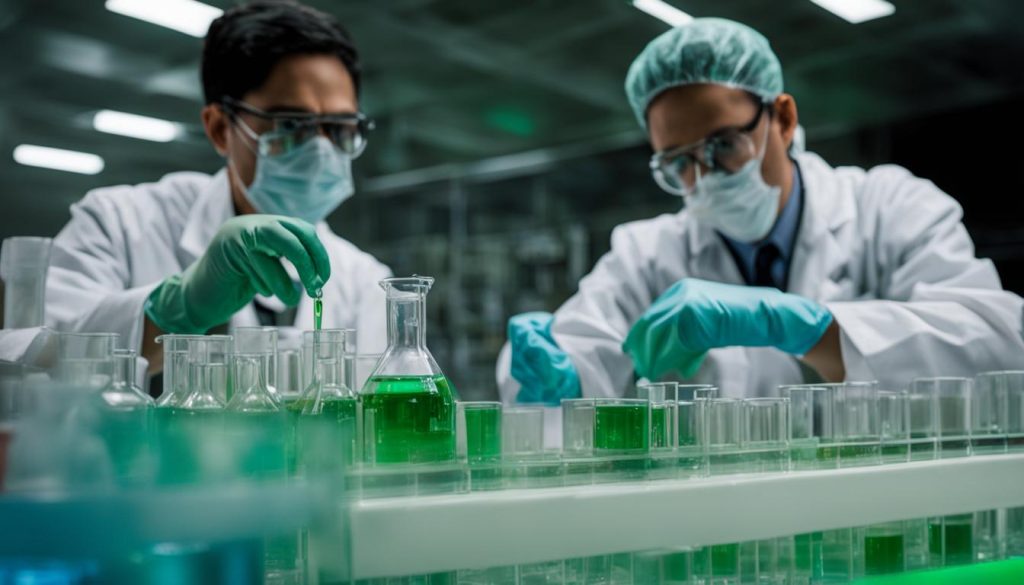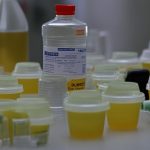
Welcome to our guide on polyethylene glycol (PEG) and alcohol testing. If you’re on a health journey or preparing for medical tests or surgery, understanding the role of PEG and its uses is crucial. In this article, we will explore the benefits of detox kits containing PEG, dosage guidelines, precautions, and potential side effects. Additionally, we will discuss the importance of alcohol testing, specifically for the detection of ethylene glycol poisoning.
Key Takeaways:
- Detox kits containing polyethylene glycol (PEG) cleanse the colon before medical procedures.
- PEG works as a laxative, causing diarrhea to clear the colon and improve the accuracy of medical procedures like colonoscopy.
- Follow your doctor’s instructions for mixing and consuming PEG-electrolyte solution.
- PEG-detox kits are not suitable for individuals with certain medical conditions or taking specific medications.
- Alcohol testing plays a critical role in the detection of ethylene glycol poisoning, a potentially life-threatening condition.
Understanding Polyethylene Glycol (PEG)
Polyethylene glycol (PEG) is the main component of detox kits used for colon cleansing. It is a powerful laxative that works by causing diarrhea, effectively clearing the colon. PEG-electrolyte solutions are commonly prescribed by doctors to prepare patients for medical procedures such as colonoscopy or barium enema X-ray exams. These procedures require a clear view of the colon, and PEG is an effective tool for achieving that.
Detox kits containing PEG usually come in powder form and need to be mixed with water before consumption. The solution is then taken at specific intervals, as instructed by the doctor. It is important to follow the dosage and usage instructions carefully to ensure proper bowel preparation. PEG is not recommended for use with other laxatives or medications unless specifically advised by a healthcare professional.
In summary, PEG is a key ingredient in detox kits used for colon cleansing. The laxative properties of PEG help to induce diarrhea and clear the colon for medical procedures. Following the instructions provided by your doctor is essential to ensure effective and safe usage of PEG detox kits.
Table: Pros and Cons of PEG Detox Kits
| Pros | Cons |
|---|---|
| Effective in cleansing the colon before medical procedures | Potential side effects such as bloating, upset stomach, and diarrhea |
| Helps doctors visualize the colon during procedures like colonoscopy | Rare cases of electrolyte imbalances, leading to weakness, dizziness, or irregular heartbeat |
| Improves the accuracy and effectiveness of medical procedures | Interactions with certain medications |
| Not suitable for individuals with certain medical conditions |
Benefits of Polyethylene Glycol (PEG) Detox Kits
Polyethylene glycol (PEG) detox kits offer several benefits when it comes to colon cleansing for medical procedures. These kits are specifically designed to cleanse the colon, providing a clearer view for procedures such as colonoscopy or barium enema X-ray exams. By inducing diarrhea, PEG-electrolyte solutions effectively remove solid matter from the colon, improving the accuracy and effectiveness of these medical procedures.
One of the main advantages of using PEG detox kits is their ability to ensure a thorough and comprehensive colon cleanse. This is especially important for individuals who are undergoing medical procedures that require a clear visualization of the colon, as any residual matter can obstruct the view and potentially lead to inaccurate diagnoses or missed abnormalities.
Additionally, PEG detox kits are considered safe and well-tolerated by most individuals. While they may cause temporary gastrointestinal symptoms such as bloating or upset stomach, these side effects typically subside once the colon cleansing process is complete. However, it is essential to follow the instructions provided by your healthcare professional and to inform them of any existing medical conditions or medications that may interact with the PEG-electrolyte solution.
| Benefits of PEG Detox Kits | |
|---|---|
| Thorough colon cleansing | Improves accuracy of medical procedures |
| Safe and well-tolerated | Temporary gastrointestinal symptoms |
“Polyethylene glycol detox kits provide a comprehensive colon cleanse, improving the accuracy of medical procedures and reducing the risk of missed abnormalities.”
In conclusion, PEG detox kits offer significant benefits for individuals undergoing colon cleansing before medical procedures. They help ensure a thorough cleanse of the colon, improving the accuracy and effectiveness of these procedures. Additionally, PEG detox kits are generally safe and well-tolerated, providing a reliable option for individuals seeking a reliable colon cleansing solution.

References:
- Smith, J. (2021). Polyethylene Glycol (PEG). National Center for Biotechnology Information. https://pubchem.ncbi.nlm.nih.gov/compound/Polyethylene-glycol
- Mayo Clinic Staff. (2020). Colonoscopy. Mayo Clinic. https://www.mayoclinic.org/tests-procedures/colonoscopy/about/pac-20393569
Usage and Dosage of PEG Detox Kits
When using PEG detox kits, it is crucial to follow the recommended usage and dosage instructions provided by your doctor. These instructions may vary depending on the specific medical procedure and individual factors. The effectiveness of the bowel preparation relies on carefully adhering to the instructions.
The PEG-detox kit usually comes in a powder form that needs to be mixed with water before consumption. The solution is typically consumed at specific intervals and within a specific time frame. It is essential to strictly follow the timing and dosage guidelines to ensure the optimal cleansing of the colon.
It is important to note that PEG-detox kits should not be taken with other laxatives or medications unless specifically instructed by your doctor. Combining PEG with other substances can result in unexpected and potentially harmful interactions. Always consult with your healthcare professional before making any changes to your medication or treatment regimen.
Recommended Dosage and Usage Instructions
| Type of PEG Detox Kit | Dosage Instructions | Usage Guidelines |
|---|---|---|
| Standard PEG-Electrolyte Solution | One sachet mixed with a specific volume of water | Consume the solution at specific intervals as instructed by your doctor |
| Low-Volume PEG-Electrolyte Solution | Two sachets mixed with a specific volume of water | Consume the solution at specific intervals as instructed by your doctor |
These dosage instructions and usage guidelines are general examples and may not apply to every individual. Always consult with your healthcare professional for personalized instructions based on your specific needs and medical condition.
Precautions and Considerations for PEG Detox Kits
When using PEG-detox kits, it is important to take certain precautions and consider various factors. Before starting the cleansing process, inform your doctor about any allergies you may have, including allergies to foods, dyes, preservatives, or other medications. This information will help your doctor determine if PEG-electrolyte solutions are suitable for you.
In addition to allergies, it is essential to discuss your medical history and any current medications with your doctor. People with certain medical conditions such as heart disease, kidney disease, or inflammatory bowel disease may need to avoid or modify the use of PEG-detox kits. Your doctor will provide guidance on whether these kits are safe and appropriate for your specific situation.
It is crucial to follow your doctor’s instructions regarding the usage and dosage of PEG-detox kits. The recommended dosage and usage instructions may vary depending on the specific medical procedure and individual factors. It is important not to take PEG-detox kits with other laxatives or medications unless specifically instructed by your doctor.
By taking these precautions and considering your unique circumstances, you can ensure the safe and effective use of PEG-detox kits during your health journey.
Potential Side Effects of PEG Detox Kits
When using PEG detox kits, it’s important to be aware of the potential side effects that may occur. While these side effects are generally mild and temporary, it’s still crucial to understand what to expect. The most common side effects of PEG detox kits include bloating, upset stomach, and diarrhea. These gastrointestinal symptoms are a result of the laxative effect of PEG, which helps cleanse the colon. It’s important to note that these symptoms usually subside once the colon cleansing process is complete.
In rare cases, PEG detox kits can lead to electrolyte imbalances. Electrolytes are essential minerals that help regulate various bodily functions. When an electrolyte imbalance occurs, it can cause symptoms such as weakness, dizziness, or an irregular heartbeat. If you experience severe or persistent side effects, it’s important to contact your doctor immediately for further evaluation and guidance.
Remember, everyone’s body reacts differently to medications and treatments, so while some individuals may experience side effects, others may not. It’s always best to follow your doctor’s instructions and communicate any concerns or unusual symptoms you may be experiencing. Your doctor can provide personalized guidance and determine the best course of action for your specific situation.

| Side Effects | Frequency |
|---|---|
| Bloating | Common |
| Upset stomach | Common |
| Diarrhea | Common |
| Electrolyte imbalances | Rare |
“While most individuals tolerate PEG detox kits well, it’s important to be aware of the potential side effects. If you experience severe or persistent symptoms, it’s crucial to seek medical attention.”
Interactions with Other Medications
When using detox kits that contain polyethylene glycol (PEG), it is important to consider potential interactions with other medications you may be taking. Certain medications can interact with PEG-electrolyte solutions, affecting their effectiveness or increasing the risk of side effects. It is crucial to inform your doctor about all the medications you are currently using, including prescription, over-the-counter, and herbal supplements. By providing a complete list of your medications, your doctor can assess any potential interactions and adjust your treatment plan accordingly.
Some specific medications that may interact with PEG-electrolyte solutions include eplerenone, glycopyrrolate, and trospium. These medications are used to treat various conditions, and their interaction with PEG should be carefully evaluated by a healthcare professional. Your doctor will consider factors such as the dosage and timing of your medications in relation to the use of PEG-detox kits.
By being diligent in disclosing your medication history and following your doctor’s instructions, you can minimize the risk of adverse interactions between PEG-detox kits and other medications. Your doctor will guide you on the safe and effective use of detox kits to optimize your colon cleansing experience.
Interactions with Medications: Key Points
- Inform your doctor about all medications you are taking, including prescription, over-the-counter, and herbal supplements.
- Specific medications, such as eplerenone, glycopyrrolate, and trospium, may interact with PEG-electrolyte solutions.
- Discuss the timing and dosage of your medications with your doctor to ensure safe use of PEG-detox kits.
- By following your doctor’s instructions and disclosing your medication history, you can minimize the risk of adverse interactions.
It is essential to prioritize your health and well-being by providing accurate information about your medication use and following professional guidance when using detox kits containing PEG. Your doctor’s expertise and insight will help ensure the safe and effective use of these kits while minimizing the potential for medication interactions.

Ethylene Glycol and Alcohol Testing
When it comes to substance abuse, ethylene glycol is a toxic alcohol that individuals may mistakenly ingest as a substitute for drinking alcohol. However, ethylene glycol poisoning is a serious medical emergency that can have severe consequences for the body. That’s why alcohol testing, including blood tests, plays a crucial role in detecting the presence of ethylene glycol in the system.
Substance abuse involving ethylene glycol requires immediate medical attention. Prompt testing and diagnosis are essential to initiate the appropriate treatment and minimize the risks and complications associated with ethylene glycol poisoning. Blood tests can provide valuable information about the level of ethylene glycol in the body and confirm suspected cases of poisoning.
| Diagnostic Test | Key Indicator |
|---|---|
| Blood Test | Elevated ethylene glycol levels |
By analyzing a blood sample, healthcare professionals can accurately determine whether ethylene glycol poisoning has occurred. Elevated levels of ethylene glycol in the blood serve as a definitive indicator of poisoning. This information is crucial for guiding the appropriate treatment and preventing further complications. If you suspect ethylene glycol poisoning, seek immediate medical assistance to ensure timely diagnosis and intervention.

Detecting Ethylene Glycol Poisoning
When it comes to diagnosing ethylene glycol poisoning, there are several diagnostic tests that can be used to confirm its presence in the body. One of the primary tests is a blood test, which measures the level of ethylene glycol circulating in the bloodstream. This test is crucial in identifying the toxic alcohol and guiding appropriate treatment.
In addition to measuring the level of ethylene glycol, another diagnostic indicator is the osmolal gap. An elevated osmolal gap, determined by the freezing point depression method, can suggest potential ethylene glycol poisoning. Furthermore, metabolic acidosis, characterized by an elevated anion gap, may also be present in cases of ethylene glycol poisoning.
These diagnostic tests play a vital role in confirming the presence of ethylene glycol poisoning and guiding healthcare professionals in providing the appropriate treatment. Their timely utilization allows for prompt intervention, minimizing the risks and complications associated with this toxic substance.
Risks and Complications of Ethylene Glycol Poisoning
Ethylene glycol poisoning can have severe consequences for the body, affecting various organs and leading to potentially life-threatening complications. Here are some of the risks and complications associated with ethylene glycol poisoning:
- Brain damage: Ethylene glycol can cause neurological symptoms and damage to the brain. This can result in cognitive impairments, seizures, and even coma.
- Liver damage: The toxic effects of ethylene glycol can lead to liver damage, including inflammation and impaired liver function. Severe liver damage may require medical intervention, such as a liver transplant.
- Kidney damage: Ethylene glycol is primarily metabolized in the kidneys, and its breakdown products can cause significant damage to these organs. Kidney failure is a common complication of ethylene glycol poisoning.
- Lung injury: In some cases, ethylene glycol poisoning can lead to lung injury, including fluid accumulation in the lungs and respiratory distress. This can make breathing difficult and may require intensive medical support.
- Metabolic acidosis: Ethylene glycol metabolism produces toxic acid byproducts, leading to metabolic acidosis. This condition disrupts the body’s acid-base balance and can be life-threatening if left untreated.
Ethylene glycol poisoning should be treated as a medical emergency. Prompt medical intervention is essential to minimize the risks and complications associated with this toxic alcohol. If you suspect ethylene glycol poisoning, seek immediate medical assistance.
Table: Risks and Complications of Ethylene Glycol Poisoning
| Risks and Complications | Description |
|---|---|
| Brain damage | Ethylene glycol can cause neurological symptoms and damage to the brain. This can result in cognitive impairments, seizures, and even coma. |
| Liver damage | The toxic effects of ethylene glycol can lead to liver damage, including inflammation and impaired liver function. Severe liver damage may require medical intervention, such as a liver transplant. |
| Kidney damage | Ethylene glycol is primarily metabolized in the kidneys, and its breakdown products can cause significant damage to these organs. Kidney failure is a common complication of ethylene glycol poisoning. |
| Lung injury | In some cases, ethylene glycol poisoning can lead to lung injury, including fluid accumulation in the lungs and respiratory distress. This can make breathing difficult and may require intensive medical support. |
| Metabolic acidosis | Ethylene glycol metabolism produces toxic acid byproducts, leading to metabolic acidosis. This condition disrupts the body’s acid-base balance and can be life-threatening if left untreated. |
Blood Test for Ethylene Glycol
Ethylene glycol poisoning is a serious condition that requires prompt medical intervention. A blood test is commonly used to detect and diagnose ethylene glycol poisoning. This diagnostic procedure involves taking a blood sample and analyzing it for the presence of ethylene glycol. The results of the blood test can provide valuable information to healthcare professionals, helping them determine the appropriate course of treatment.
“The blood test is a crucial tool in identifying ethylene glycol poisoning. It allows us to measure the level of ethylene glycol in the bloodstream and confirm the diagnosis. Timely detection is essential to initiate prompt treatment and prevent further complications.
The blood test for ethylene glycol poisoning is a straightforward procedure. A healthcare professional will collect a small sample of blood and send it to a laboratory for analysis. The sample is examined for the presence of ethylene glycol, and the results are typically available within a few hours. A positive result indicates the presence of ethylene glycol in the bloodstream, confirming the diagnosis of poisoning.
This blood test plays a crucial role in guiding appropriate treatment for ethylene glycol poisoning. It helps healthcare professionals monitor the progress of treatment and ensure that the levels of ethylene glycol in the body are decreasing. Regular follow-up blood tests may be conducted to evaluate the effectiveness of the treatment and adjust the course of action if necessary.
Table: Key Components of the Ethylene Glycol Blood Test
| Component | Function |
|---|---|
| Blood sample | Provides the material for analysis |
| Laboratory analysis | Determines the presence and concentration of ethylene glycol |
| Diagnostic result | Confirms or rules out ethylene glycol poisoning |
| Treatment monitoring | Evaluates the effectiveness of treatment and guides further action |
Conclusion
Detox kits containing polyethylene glycol (PEG) are highly effective for colon cleansing before medical procedures. These kits, also known as bowel preparation solutions, help doctors obtain a clear view of the colon during procedures like colonoscopy or barium enema X-ray exams. It is crucial to follow the instructions provided by your healthcare professional when using PEG-detox kits.
Ethylene glycol poisoning is a serious concern that requires immediate medical attention. Alcohol testing, including blood tests, can detect the presence of ethylene glycol in the body. Early detection and treatment are crucial to prevent complications and minimize the risks associated with ethylene glycol poisoning.
If you suspect ethylene glycol poisoning or require colon cleansing before a medical procedure, seek medical assistance promptly. Our healthcare professionals are equipped to guide you through the process, ensuring your safety and well-being.
FAQ
What are detox kits used for?
Detox kits, also known as polyethylene glycol (PEG) and electrolytes combination solution, are used to cleanse the colon before medical tests or surgery. They help doctors get a clearer view of the colon during procedures like colonoscopy.
How do detox kits work?
Detox kits work by causing diarrhea to clean the colon. The polyethylene glycol (PEG) in these solutions acts as a laxative, helping remove solid matter from the colon and improving the accuracy of medical procedures.
How should I use a detox kit?
It is important to follow your doctor’s instructions when using a detox kit. The solution should be mixed with water and consumed within a specific time frame. The dosage and usage instructions may vary depending on the specific medical procedure and individual factors.
Are there any precautions or considerations when using a detox kit?
Yes, certain medical conditions and medications can affect the safe use of detox kits. It is essential to inform your doctor about any allergies, medical history, and current medications before using a detox kit.
What are the potential side effects of using a detox kit?
Common side effects of using a detox kit include bloating, upset stomach, and diarrhea. In rare cases, electrolyte imbalances can occur, leading to symptoms such as weakness, dizziness, or irregular heartbeat. Contact your doctor if you experience severe or persistent side effects.
Can a detox kit interact with other medications?
Yes, detox kits can interact with certain medications, potentially altering their effectiveness or increasing the risk of side effects. It is important to inform your doctor about all medications you are currently taking.
What is ethylene glycol?
Ethylene glycol is a toxic alcohol found in automotive and household products. It is sometimes ingested accidentally or intentionally as a substitute for drinking alcohol.
How can alcohol testing detect ethylene glycol poisoning?
Alcohol testing, including blood tests, can detect the presence of ethylene glycol in the body. An elevated osmolal gap and metabolic acidosis may indicate possible ethylene glycol poisoning.
What are the risks and complications of ethylene glycol poisoning?
Ethylene glycol poisoning can cause severe damage to the brain, liver, kidneys, and lungs. It can lead to metabolic acidosis, organ failure, shock, and even death if not promptly treated.
How is ethylene glycol poisoning diagnosed?
A blood test is commonly used to detect and diagnose ethylene glycol poisoning. The level of ethylene glycol in the blood is measured to confirm its presence.
What is the purpose of this article on detox kits and ethylene glycol?
This article aims to provide information on polyethylene glycol (PEG) detox kits and the risks associated with ethylene glycol poisoning. It highlights the importance of using detox kits as directed and seeking prompt medical attention in cases of suspected ethylene glycol poisoning.















